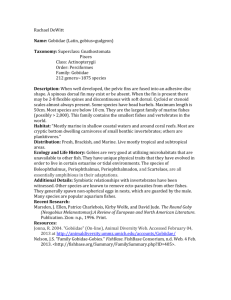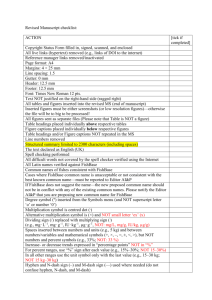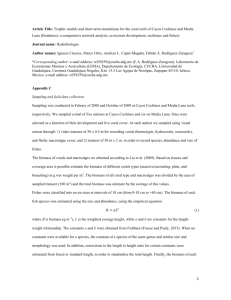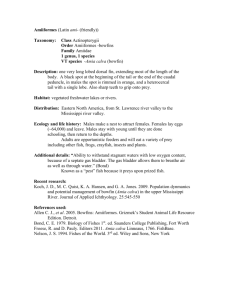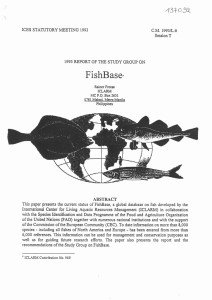DOC - FishBase
advertisement
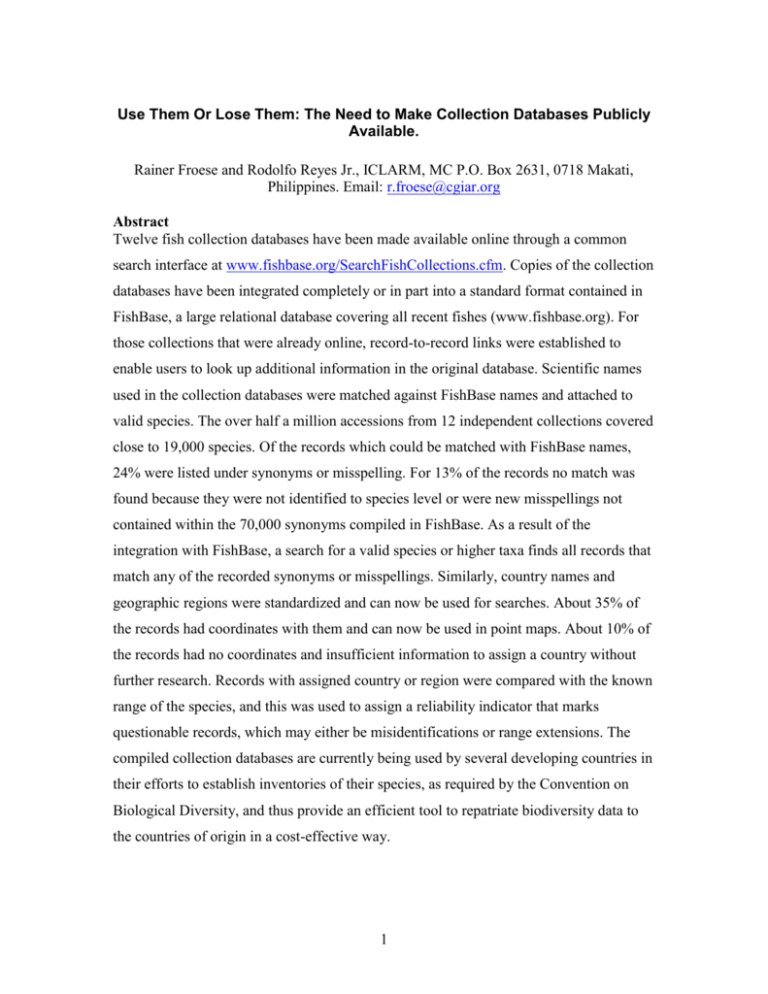
Use Them Or Lose Them: The Need to Make Collection Databases Publicly Available. Rainer Froese and Rodolfo Reyes Jr., ICLARM, MC P.O. Box 2631, 0718 Makati, Philippines. Email: r.froese@cgiar.org Abstract Twelve fish collection databases have been made available online through a common search interface at www.fishbase.org/SearchFishCollections.cfm. Copies of the collection databases have been integrated completely or in part into a standard format contained in FishBase, a large relational database covering all recent fishes (www.fishbase.org). For those collections that were already online, record-to-record links were established to enable users to look up additional information in the original database. Scientific names used in the collection databases were matched against FishBase names and attached to valid species. The over half a million accessions from 12 independent collections covered close to 19,000 species. Of the records which could be matched with FishBase names, 24% were listed under synonyms or misspelling. For 13% of the records no match was found because they were not identified to species level or were new misspellings not contained within the 70,000 synonyms compiled in FishBase. As a result of the integration with FishBase, a search for a valid species or higher taxa finds all records that match any of the recorded synonyms or misspellings. Similarly, country names and geographic regions were standardized and can now be used for searches. About 35% of the records had coordinates with them and can now be used in point maps. About 10% of the records had no coordinates and insufficient information to assign a country without further research. Records with assigned country or region were compared with the known range of the species, and this was used to assign a reliability indicator that marks questionable records, which may either be misidentifications or range extensions. The compiled collection databases are currently being used by several developing countries in their efforts to establish inventories of their species, as required by the Convention on Biological Diversity, and thus provide an efficient tool to repatriate biodiversity data to the countries of origin in a cost-effective way. 1 Introduction At the beginning of the 21st Century there is increasing recognition of the crucial role that specimen collections can play for the understanding of biotic diversity and our quest to turn the current destructive use of the living planet into a harmonized one. In order to live up to such expectations collections have to be cleaned-up and made publicly available. Public use as manifested, e.g., in ‘hits’ in the Internet and participation in international programs, can be a much more powerful advocate for an adequate share of public funds than theoretical argumentation about the importance to science. Collections that decide to remain ‘restricted’ will miss out on current opportunities and may find it difficult to obtain an adequate role in the future as others will have taken the lead and the recognition. The main problems that collections are facing are the often daunting tasks of (1) computerizing the collection, (2) correcting and standardizing scientific names and localities, (3) verifying identifications, and (4) making the information publicly available in a user-friendly interface. Computerization (item 1) is usually less difficult and timeconsuming than anticipated. For example, it took just one year to digitize the handwritten catalog with 125,000 lots of the fish collection of the Natural History Museum (BMNH). Items (2) to (4) are usually more demanding, and in this contribution we describe our preliminary experiences with a project to make fish collections publicly available. Material and Methods The data presented in this study stem from twelve fish collection databases listed in Table 1. The procedures for matching names are described in Froese (1997) and the ones for assigning reliability indicators in Froese et al. (1999). These procedures draw mainly on reference data in FishBase (www.fishbase.org), version of August 2000, a large biological database containing practically all known fish species (Froese and Pauly 2000), and on the database that forms the basis of Eschmeyer’s (1998) Catalog of Fishes (www.calacademy.org/research/ichthyology/catalog/main.htm), version of November 1999. 2 Results and Discussion As of August 2000 FishBase contained 12 collection database from 9 countries with over 522,000 collection records (see Table 1). Despite the variety of formats and software used, it took normally one week to transfer a collection database into the OCCURRENCE table of FishBase and to clean-up most of the obvious errors such as misspellings. One precondition for the integration of different collection databases is the standardization of scientific names and localities. For the checking and matching of scientific names we used the approach described by Froese (1997) and which is implemented as the ‘Check names’ routine in the CD-ROM version of FishBase. This routine compares the scientific names used in the collections with known synonyms and misspellings as contained in the SYNONYMS table of FishBase and in Eschmeyer’s (1998) Catalog. It establishes a link between unambiguous synonyms in the collections and current names in FishBase. This link remains operational even if the valid name in FishBase is changed. For non-matching collection names such as new misspellings or new combinations, the routine suggests a list of possible correct names for manual correction in the collection database. Applying this procedure resulted in 87% of the records being linked to about 19,000 valid species in FishBase. About 24% of these ‘matching’ names were synonyms or misspellings. The non-matching names were either not identified to the species level in the contributing database, or were new combinations or misspellings not easily placed into synonymies. We tried to implement three standards for localities: large geographic areas as used by FAO for continents and oceans; English ISO names of countries and islands; and regular geographic coordinates. The collections followed a variety of standards for larger areas, and we had to assign the FAO areas based on stated countries, localities and environment (marine or freshwater). Standardization of country names started with printing a unique list of names used in a given collection. Most of the necessary corrections such as typographic errors or translation from other languages were obvious. Assignment of historical names to current countries or islands was more demanding but achievable for the majority of cases. Names of smaller islands were often difficult to trace, especially when no coordinates or other geographic indicators were given. Electronic gazetteers such as the Encarta World Atlas with 1.2 million place names were helpful for this task. 3 Typographical errors in coordinates were common and not easily detected. We applied the methods discussed in Froese et al. (1999) to detect points that were outside the range of a given FAO area or country, or that placed marine species on land, freshwater species in the ocean, or, e.g., tropical species in other climate zones. We also used a routine in FishBase to detect records that were outside the established range of a species, and thus either erroneous, range extensions, or misidentifications. About 35% of the records had coordinates with them and can now be used in point maps (Fig. 1). About 10% of the records had no coordinates and insufficient information to assign a country without further research. The most important question about collection records is whether the identification of the specimen is correct. We applied the method of Froese et al. (1999) which compared every collection record with reference information in FishBase and assigned a reliability NIACC indicator, detailing the confidence in the given scientific Name, Identifier, Area, Country and Coordinates in a five digit number, where every digit stands for one of these categories and numbers indicate probability of correctness, with some variation between categories, as: 1 = high, 2 = medium, 3 = low (probably wrong), 4 = no data available, and 5 = not yet evaluated. The most common combination was NIACC 14114 (18 % of records with matching names in FishBase), suggesting reliable records within the known range, but without evaluation of the identifier and without coordinates. Other telling combinations were NIACC 11111 (735 records), referring to records with unambiguous scientific name, a family expert as identifier, and reported from within the known range of the species. In contrast, NIACC 23331 (28 records) indicated records where the species had been misidentified before, the identifier was unknown, and the locality (with consistent coordinates) was clearly outside the established range, i.e., most likely these were misidentifications. The NIACC 11131 (46 records), on the other hand, suggested a wellidentified species occurring in a new country within its broader distributional range. 4 A remaining problem with our approach to incorporating collection databases in FishBase is the difficulty of establishing a functioning updating loop where the errors found by the FishBase team and communicated to the contributing collections are corrected in the originating databases, and improved versions of those databases are sent to FishBase, e.g., every year, to completely replace the previous versions. In our experience most curators were for various reasons unable to verify and apply the corrections we sent them. An alternative approach where the collection databases remain at their respective locations and are polled when needed through the Internet is unsatisfactory in comparison as records with non-matching scientific or locality names will not be detected nor corrected, thus leaving a large number of records unused. Also, such approach depends on all databases being available on-line and all Internet connections being faster than various time-out limits in order to create reproducible results. Maybe the best solution is a hybrid approach where only part of the data (name, date, locality, coordinates, identifier) are standardized and hold and updated centrally for fast access with reproducible results, and where another part with additional information is linked and maintained in the contributing database only. In summary, tools are available to largely clean-up fish collection databases and to make them available for research and public use. However, curators will need support to make the necessary corrections and standardizations in their respective databases. Eschmeyer (1998) listed 457 fish collections of which 64 had home pages in the Internet and 24 could be searched through their own interface in August 2000. The NEODAT Project (www.neodat.org) provided access to eight of these online databases plus to an additional 16 collections, however restricted to neotropical fishes. The total number of fish accessions (= lots) in all existing collections was estimated at about 10 million by Froese et al. (1999). The twelve databases and 520,000 records investigated in this study thus present only about 5% of the total and therefore the various trends we describe may change as more collections are added. Currently the apparent gaps of fish collection records shown in Fig. 1 reflect more the intermediate status of our work than biodiversity patterns. We expect the patterns to become more meaningful once a threshold of, e.g., 2 million accessions is surpassed. Several additional museums have already declared their 5 willingness to make their collections available through FishBase (e.g. AMNH, RUSI, UF). The compiled collection databases are being used by several developing countries in their efforts to establish inventories of their species (see Ramjohn 1999 as example), as required by the Convention on Biological Diversity. Access through one interface thus provides an efficient tool in an effort to repatriate biodiversity data to the countries of origin in a cost-effective and useful manner. The public interest in scientific information on fishes is often underestimated. The FishBase web site entertained about half a million hits and 40,000 user sessions per month during the first half of 2000. Since August 1998 the site had altogether 206,000 unique visitors of whom 34,000 visited more than once and used the database for an average of 14 minutes per session. If the voluntary entries in the FishBase guest book are taken as a measure then one third of the users were individuals (non-scientists), one third came from Universities, and the rest were from the private sector, governments, and nongovernmental organizations. Museum data are featured at several locations in the FishBase web site, including various biodiversity maps. Links to the home pages of the museums and to online collections are provided whenever museum data are shown, thus giving visible credit to the contributing institutions. This is even true for maps, where a click on a point will show the underlying data. Please contact the first author if you want to contribute to the approach described in this study. Acknowledgements We thank the contributing databases for their trust in and support of the FishBase vision. We thank the FishBase team for encoding the reference data that allowed us to do this study. This research was conducted partly under the joint Fisheries Research Initiative of African, Caribbean and Pacific (ACP) countries with the European Union and was sponsored in the framework of the capacity building project ‘Strengthening of fisheries and biodiversity management in ACP countries’ (7.ACP.RPR.545). It was also partly conducted under the ‘Census of Marine Fishes’ project funded by the Sloan Foundation. ICLARM Contribution No. xxxx. 6 References Eschmeyer, W.N. Editor. 1998. Catalog of Fishes. Special Publication, California Academy of Sciences, San Francisco. 3 vols. 2905 p. Froese, R. 1997. An algorithm for identifying misspellings and synonyms in lists of scientific names of fishes. Cybium 21(3):265-280 Froese, R. N. Bailly, G. Coronado, P. Pruvost, R. Reyes Jr. and J.-C. Hureau. 1999. A new procedure to evaluate fish collection databases. p. 697-705 In B. Séret and J.Y. Sire (eds.) Proc. 5th Indo-Pac. Fish Conf., Soc. Fr. Ichthyol., Paris Froese, R. and D. Pauly. Editors. 2000. FishBase 2000: concepts, design and data sources. ICLARM, Los Bãnos, Philippines. Ramjohn, D.D. 1999. Checklist of coastal and marine fishes of Trinidad and Tobago. Marine Fishery Analysis Unit, Fisheries Division, Ministry of Agriculture, Land and Marine Resources, Trinidad and Tobago. Fisheries Information Series No. 8, 151 p. 7 Table 1. Fish collections contained in FishBase as of August 2000. Online refers to the Internet availability of the contributing database independent of FishBase. Record numbers marked with * are incomplete. File format refers to the format used for transferring data. Museum BMNH BPBM CAS CICIMAR-IPN GCRL ISH MNHN MRAC NMK NRM UBC ZMH City London, UK Honolulu, Hawaii, USA San Francisco, California, USA La Paz, Mexico Ocean Springs, Mississippi, USA Hamburg, Germany Paris, France Brussels, Belgium Nairobi, Kenya Stockholm, Sweden Vancouver, Canada Hamburg, Germany 8 Online Records Species File Format No 125212 11932 MS Access No *9027 2332 Dbase No 143319 11503 Dbase No 4515 486 MS Excel No 28471 2801 Dbase No *3922 307 MS Access Yes 78163 8912 MS Access No *46259 1537 Text No 1115 349 MS Excel Yes 22983 3839 MS Access No 24602 2072 MS Excel Yes 20233 4130 Dbase Figure 1. Map with about 175,000 fish collection sites as contained in FishBase. Black dots mark probably erroneous records. 9
